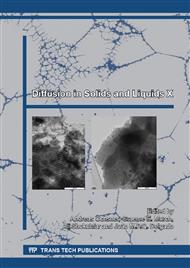p.194
p.200
p.207
p.212
p.219
p.226
p.232
p.237
p.244
Physical - Chemistry Characterization of Sweet Sorghum Bagasse in Nature and Delignificate with NaOH to Produce Bioethanol
Abstract:
Lignocellulosic wastes are the most abundant in the world and there is currently a global concern to harness them as biomass to produce cellulosic ethanol, being possible due to the materials being rich in cellulose. The main goal of this work is to produce the delignification from Sweet Sorghum waste free from extractives as well as the physico-chemical characterization in the natural state after being delignificated aiming to remove the lignin that acts as a barrier preventing access of the enzyme to the cellulose in the enzymatic hydrolysis processes. The following tests were performed: moisture, ash, cellulose, lignin, hemicelluloses, AR, extractives, XRD and SEM. Aftter the procedure of delignification, it was characterized as cellulose, lignin, XRD and SEM to check if there was removal of the lignin and if there was no change in crystallinity. The characterization showed that the Sweet Sorghum waste is a viable alternative for the production of bioethanol and proved to be an important source of cellulose presenting a content of glucose of 45.99 ± 0.63% and a lignin content of 14.63 ± 0.23%. The Sweet Sorghum waste was deslignificated by pulping with sodium hydroxide (NaOH) process, using as an experimental tool design type 23 with 3 replications at the center point, to evaluate the effect of independent variables temperature, such as concentration of the NaOH solution and the time dependent variable in the delignification. The planning showed through the Pareto ́s diagram that the most influential variable in the process was the concentration which showed a response of 75.1258 and a greater interaction occurred on the variables temperature and concentration with a response of 1.653117. The regression model as well as being a statistically significant predictor, also presents a reason F calculated and F tabulated of 10.10 and achieving a maximum yield of 57.85% delignification. After delignification processes the waste showed a rate of 5.81 ± 0.18% lignin and 43.13 ± 0.53% cellulose , as well as an increase in crystallinity, verified by analysis of SEM and XRD .
Info:
Periodical:
Pages:
219-225
Citation:
Online since:
July 2015
Keywords:
Price:
Сopyright:
© 2015 Trans Tech Publications Ltd. All Rights Reserved
Share:
Citation:


